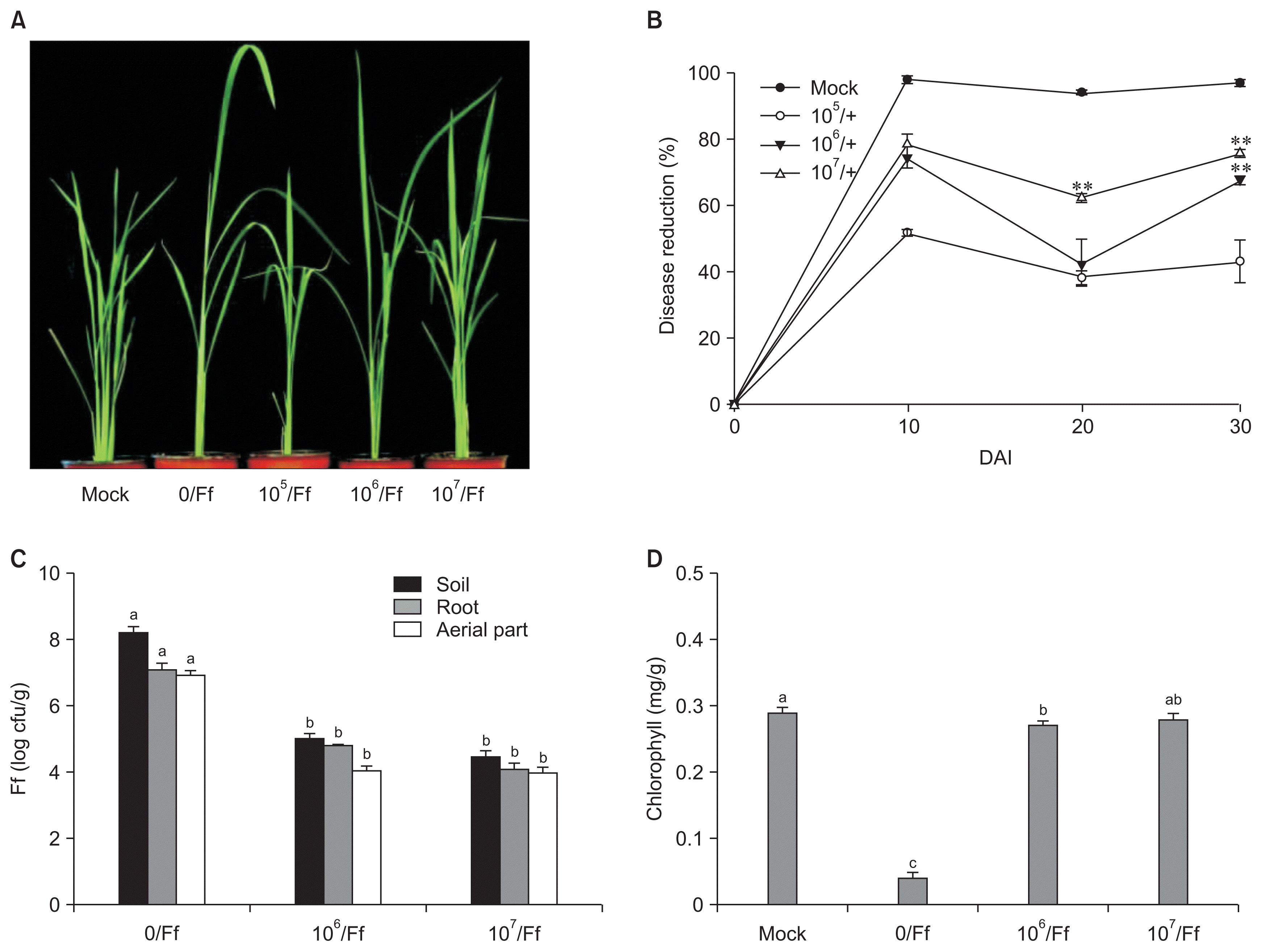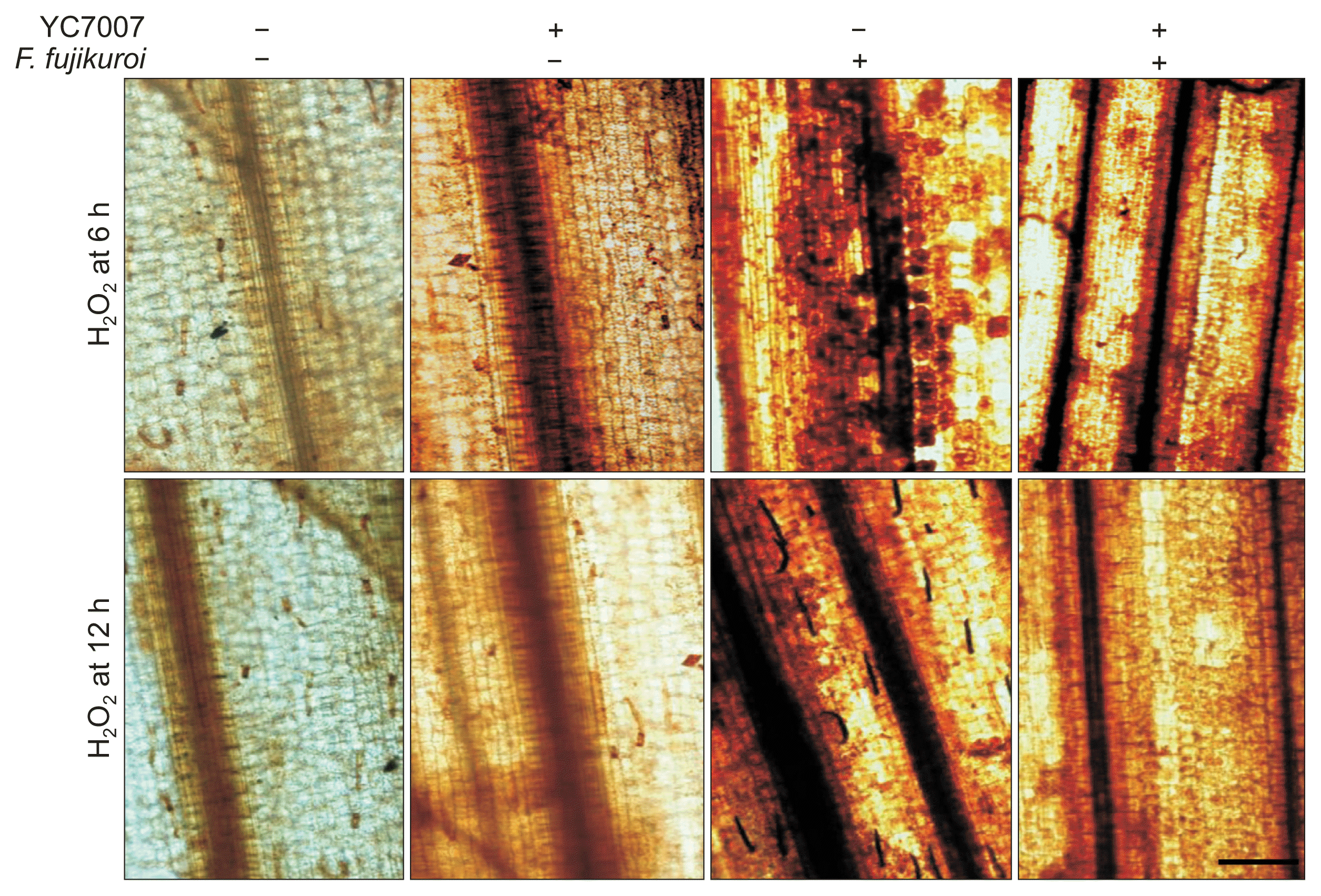Ahn, IP, Lee, SW and Suh, SC 2007. Rhizobacteria-induced priming in Arabidopsis is dependent on ethylene, jasmonic acid, and NPR1.
Mol Plant-Microbe Interact. 20:759-768.


Alquéres, S, Meneses, C, Rouws, L, Rothballer, M, Baldani, I, Schmid, M and Hartmann, A 2013. The bacterial superoxide dismutase and glutathione reductase are crucial for endophytic colonization of rice roots by Gluconacetobacter diazotrophicus PAL5.
Mol Plant-Microbe Interact. 26:937-945.


Amatulli, MT, Spadaro, D, Gullino, ML and Garibaldi, A 2010. Molecular identification of Fusarium spp. associated with bakanae disease of rice in Italy and assessment of their pathogenicity.
Plant Pathol. 59:839-844.

Aslam, Z, Yasir, M, Yoon, HS, Jeon, CO and Chung, YR 2013. Diversity of the bacterial community in the rice rhizosphere managed under conventional and no-tillage practices.
J Microbiol. 51:747-756.



Berg, G, Mahnert, A and Moissl-Eichinger, C 2014. Beneficial effects of plant-associated microbes or indoor microbiomes and human health?
Front Microbiol. 5:15


Bonman, JM 1992. Root and crown disease, bakanae. In: Compendium of rice diseases, eds. by RK Webster and PS Gunnell, 27. APS Press, St. Paul, MN, USA.
Bordiec, S, Paquis, S, Lacroix, H, Dhondt, S, Ait Barka, E, Kauffmann, S, Jeandet, P, Mazeyrat-Gourbeyre, F, Clément, C, Baillieul, F and Dorey, S 2011. Comparative analysis of defence responses induced by the endophytic plant growth-promoting rhizobacterium Burkholderia phytofirmans strain PsJN and the non-host bacterium Pseudomonas syringae pv. pisi in grapevine cell suspensions.
J Exp Bot. 62:595-603.


Carter, LL, Leslie, JF and Webster, RK 2008. Population structure of Fusarium fujikuroi from California rice and water grass.
Phytopathology. 98:992-998.


Castella, G, Bragulat, MR, Rubiales, MV and Cabanes, FJ 1997. Malachite green agar, a new selective medium for Fusarium spp.
Mycopathologia. 137:173-178.

Chung, EJ, Hossain, MT, Khan, A, Kim, KH, Jeon, CO and Chung, YR 2015. Bacillus oryzicola sp. nov., an endophytic bacterium isolated from the root of rice with antimicrobial, plant-growth promoting and systemic resistance-inducing activities in rice.
Plant Pathol J. 31:152-164.


Coutinho, BG, Licastro, D, Mendonça-Previato, L, Cámara, M and Venturi, V 2015. Plant-influenced gene expression in the rice endophyte Burkholderia kururiensis M130.
Mol Plant-Microbe Interact. 28:10-21.


Crane, JM, Gibson, DM, Vaughan, RH and Bergstrom, GC 2013. Iturin levels on wheat spikes linked to biological control of Fusarium head blight by Bacillus amyloliquefaciens.
Phytopathology. 103:146-155.


De Vleesschauwer, D, Djavaheri, M, Bakker, PA and Höfte, M 2008. Pseudomonas fluorescens WCS374r-induced systemic resistance in rice against Magnaporthe oryzae is based on pseudobactin-mediated priming for a salicylic acid-repressible multifaceted defense response.
Plant Physiol. 148:1996-2012.



De Vleesschauwer, D, Van Buyten, E, Satoh, K, Balidion, J, Mauleon, R, Choi, IR, Vera-Cruz, C, Kikuchi, S and Höfte, M 2012. Brassinosteroids antagonize gibberellin- and salicylate-mediated root immunity in rice.
Plant Physiol. 158:1833-1846.




Dimkic, I, Zivkovic, S, Beric, T, Ivanovic, Z, Gavrilovic, V, Stankovic, S and Fira, D 2013. Characterization and evaluation of two Bacillus strains, SS-12.6 and SS-13.1, as potential agents for the control of phytopathogenic bacteria and fungi.
Biol Control. 65:312-321.

Fanata, WI, Lee, KH, Son, BH, Yoo, JY, Harmoko, R, Ko, KS, Ramasamy, NK, Kim, KH, Oh, DB, Jung, HS, Kim, JY, Lee, SY and Lee, KO 2013. N-glycan maturation is crucial for cytokinin-mediated development and cellulose synthesis in Oryza sativa.
Plant J. 73:966-979.


Gnanamanickam, SS 2009. An overview of progress in biological control. In:
Biological control of rice diseases: Progress in biological control Series, eds. by SS Gnanamanickam, 43-51. Springer, Dordrecht, Netherlands.

Goswami, RS and Kistler, HC 2004. Heading for disaster: Fusarium graminearum on cereal crops.
Mol Plant Pathol. 5:515-525.


Harrach, BD, Baltruschat, H, Barna, B, Fodor, J and Kogel, KH 2013. The mutualistic fungus Piriformospora indica protects barley roots from a loss of antioxidant capacity caused by the necrotrophic pathogen Fusarium culmorum.
Mol Plant-Microbe Interact. 26:599-605.


Kazempour, MN and Elahinia, SA 2007. Biological control of Fusarium fujikuroi, the causal agent of bakanae disease by rice associated antagonistic bacteria. Bulg J Agric Sci. 13:393-408.
Kim, CK 1981. Ecological studies of bakanae disease of rice caused by Gibberella fujikuroi. Kor J Plant Prot. 20:146-150.
McSpadden Gardener, BB 2004. Ecology of Bacillus and Paenibacillus spp. in agricultural systems.
Phytopathology. 94:1252-1258.


McSpadden Gardener, BB 2010. Biocontrol of plant pathogens and plant growth promotion by Bacillus. In: Recent developments in management of plant diseases, eds. by U Gisi, I Chet and M Lodovica Gullino, 71-79. Springer, Dordrecht, Netherlands.
Mendes, R, Kruijt, M, de Bruijn, I, Dekkers, E, van der Voort, M, Schneider, JH, Piceno, YM, DeSantis, TZ, Andersen, GL, Bakker, PA and Raaijmakers, JM 2011. Deciphering the rhizosphere microbiome for disease-suppressive bacteria.
Science. 332:1097-1100.


Mew, TW, Cottyn, B, Pamplona, R, Barrios, H, Xiangmin, L, Zhiyi, C, Fan, L, Nilpanit, N, Arunyanart, P, Kim, PV and Du, PV 2004. Applying rice seed-associated antagonistic bacteria to manage rice sheath blight in developing countries.
Plant Dis. 88:557-564.


Mew, TW and Gonzales, P 2002. Seed-borne fungi causing stem, leaf sheath, and root diseases in rice. In: A handbook of rice seed-borne fungi, eds. by TW Mew and P Gonzales, 31-34. Science Publishers, Enfield, NH, USA. International Rice Research Institute, Makati, Philippines.
Niu, DD, Liu, HX, Jiang, CH, Wang, YP, Wang, QY, Jin, HL and Guo, JH 2011. The plant growth-promoting rhizobacterium Bacillus cereus AR156 induces systemic resistance in Arabidopsis thaliana by simultaneously activating salicylate- and jasmonate/ethylene-dependent signaling pathways.
Mol Plant-Microbe Interact. 24:533-542.


Ongena, M, Henry, G and Thonart, P 2009. The roles of cyclic lipopeptides in the biocontrol activity of Bacillus subtilis. In:
Recent developments in management of plant diseases, eds. by U Gisi, I Chet and M Lodovica Gullino, 59-69. Springer, Dordrecht, Netherlands.

Ou, SH 1985. Bakanae disease and foot rot. In: Rice disease, 2nd ed. eds. by SH Ou, 262-272. Commonwealth Micological Institue, Kew, England.
Park, KS, Paul, D and Yeh, WH 2006. Bacillus vallismortis EXTN-1- mediated growth promotion and disease suppression in rice.
Plant Pathol J. 22:278-282.

Park, WS, Choi, HW, Han, SS, Shin, D, Shim, HK, Jung, ES, Lee, SW, Lim, CK and Lee, YH 2009. Control of bakanae disease of rice by seed soaking into the mixed solution of prochloraz and fludioxonil. Res Plant Dis. 15:94-100.
Paulitz, TC and Bélanger, RR 2001. Biological control in greenhouse systems.
Annu Rev Phytopathol. 39:103-133.


Peng, X, Hu, Y, Tang, X, Zhou, P, Deng, X, Wang, H and Guo, Z 2012. Constitutive expression of rice WRKY30 gene increases the endogenous jasmonic acid accumulation, PR gene expression and resistance to fungal pathogens in rice.
Planta. 236:1485-1498.



Pieterse, CM, Leon-Reyes, A, Van der Ent, S and Van Wees, SC 2009. Networking by small-molecule hormones in plant immunity.
Nat Chem Biol. 5:308-316.



Qin, X, Liu, JH, Zhao, WS, Chen, XJ, Guo, ZJ and Peng, YL 2013. Gibberellin 20-oxidase gene OsGA20ox3 regulates plant stature and disease development in rice.
Mol Plant-Microbe Interact. 26:227-239.


Qiu, D, Xiao, J, Ding, X, Xiong, M, Cai, M, Cao, Y, Li, X, Xu, C and Wang, S 2007. OsWRKY13 mediates rice disease resistance by regulating defense-related genes in salicylate- and jasmonate-dependent signaling.
Mol Plant-Microbe Interact. 20:492-499.


Raaijmakers, JM, De Bruijn, I, Nybroe, O and Ongena, M 2010. Natural functions of lipopeptides from Bacillus and Pseudomonas: more than surfactants and antibiotics.
FEMS Microbiol Rev. 34:1037-1062.


Rahman, A, Uddin, W and Wenner, NG 2015. Induced systemic resistance responses in perennial ryegrass against Magnaporthe oryzae elicited by semi-purified surfactin lipopeptides and live cells of Bacillus amyloliquefaciens.
Mol Plant Pathol. 16:546-558.



Riemann, M, Haga, K, Shimizu, T, Okada, K, Ando, S, Mochizuki, S, Nishizawa, Y, Yamanouchi, U, Nick, P, Yano, M, Minami, E, Takano, M, Yamane, H and Iino, M 2013. Identification of rice Allene Oxide Cyclase mutants and the function of jasmonate for defence against Magnaporthe oryzae.
Plant J. 74:226-238.


Rosales, AM and Mew, TW 1997. Suppression of Fusarium moniliforme in rice by rice-associated antagonistic bacteria.
Plant Dis. 81:49-52.


Rosales, AM, Nuque, FL and Mew, TW 1986. Biological control of bakanae diseases of rice with antagonistic bacteria. Phil Phytopath. 22:29-35.
Ryu, CM, Farag, MA, Hu, CH, Reddy, MS, Kloepper, JW and Pare, PW 2004a. Bacterial volatiles induce systemic resistance in Arabidopsis.
Plant Physiol. 134:1017-1026.



Ryu, CM, Murphy, JF, Mysore, KS and Kloepper, JW 2004b. Plant growth-promoting rhizobacteria systemically protect Arabidopsis thaliana against Cucumber mosaic virus by a salicylic acid and NPR1-independent and jasmonic acid-dependent signaling pathway.
Plant J. 39:381-392.


Sanchez, L, Courteaux, B, Hubert, J, Kauffmann, S, Renault, JH, Clément, C, Baillieul, F and Dorey, S 2012. Rhamnolipids elicit defense responses and induce disease resistance against biotrophic, hemibiotrophic, and necrotrophic pathogens that require different signaling pathways in Arabidopsis and highlight a central role for salicylic acid.
Plant Physiol. 160:1630-1641.




Sang, MK and Kim, KD 2011. Biocontrol activity and primed systemic resistance by compost water extracts against anthracnoses of pepper and cucumber.
Phytopathology. 101:732-740.


Shimizu, T, Nakano, T, Takamizawa, D, Desaki, Y, Ishii-Minami, N, Nishizawa, Y, Minami, E, Okada, K, Yamane, H, Kaku, H and Shibuya, N 2010. Two LysM receptor molecules, CEBiP and OsCERK1, cooperatively regulate chitin elicitor signaling in rice.
Plant J. 64:204-214.



Singh, PP, Shin, YC, Park, CS and Chung, YR 1999. Biological control of fusarium wilt of cucumber by chitinolytic bacteria.
Phytopathology. 89:92-99.


Sung, KC and Chung, YR 1997. Enhanced suppression of rice sheath blight using combination of bacteria which produce chitinases or antibiotics. In: Plant growth promoting Rhizobacteria: present status and future prospects, eds. by A Ogoshi, K Kobayashi, Y Homma, F Kodama, N Konodo and S Akino, 370-373. OECD, Paris, France.
Ton, J, Pieterse, CM and Van Loon, LC 1999. Identification of a locus in Arabidopsis controlling both the expression of rhizobacteria-mediated induced systemic resistance (ISR) and basal resistance against Pseudomonas syringae pv tomato.
Mol Plant-Microbe Interact. 12:911-918.


Tung, LD and Serrano, EP 2011. Effects of warm water in breaking dormancy for rice seed. Omonrice. 18:129-136.
Vallad, GE and Goodman, RM 2004. Systemic acquired resistance and induced systemic resistance in conventional agriculture.
Crop Sci. 44:1920-1934.


de Mortel, JE, de Vos, RC, Dekkers, E, Pineda, A, Guillod, L, Bouwmeester, K, van Loon, JJ, Dicke, M and Raaijmakers, JM 2012. Metabolic and transcriptomic changes induced in Arabidopsis by the rhizobacterium Pseudomonas fluorescens SS101.
Plant Physiol. 160:2173-2188.



van Loon, LC, Rep, M and Pieterse, CM 2006. Significance of inducible defense-related proteins in infected plants.
Annu Rev Phytopathol. 44:135-162.


Walters, D and Heil, M 2007. Costs and trade-offs associated with induced resistance.
Physiol Mol Plant Pathol. 71:3-17.

Walters, D, Walsh, D, Newton, A and Lyon, G 2005. Induced resistance for plant disease control: maximizing the efficacy of resistance elicitors.
Phytopathology. 95:1368-1373.


Weller, DM, Mavrodi, DV, van Pelt, JA, Pieterse, CM, van Loon, LC and Bakker, PA 2012. Induced systemic resistance in Arabidopsis thaliana against Pseudomonas syringae pv. tomato by 2,4-diacetylphloroglucinol-producing Pseudomonas fluorescens.
Phytopathology. 102:403-412.


Xie, X, Zhang, H and Pare, P 2009. Sustained growth promotion in Arabidopsis with long term exposure to the beneficial soil bacterium Bacillus subtilis (GB03).
Plant Signal Behav. 4:948-953.



Yang, YR, Kim, YC, Lee, SW, Lee, SW, An, GG and Kim, IS 2012. Involvement of an efflux transporter in prochloraz resistance of Fusarium fujikuroi CF245 causing rice bakanae disease.
J Kor Soc Appl Biol Chem. 55:571-574.


Zachow, C, Jahanshah, G, de Bruijn, I, Song, C, Ianni, F, Pataj, Z, Gerhardt, H, Pianet, I, Lämmerhofer, M, Berg, G, Gross, H and Raaijmakers, JM 2015. The novel lipopeptide poaeamide of the endophyte Pseudomonas poae re*1-1-14 is involved in pathogen suppression and root colonization.
Mol Plant-Microbe Interact. 28:800-810.


Zhang, X, Wang, C, Zhang, Y, Sun, Y and Mou, Z 2012. The Arabidopsis mediator complex subunit16 positively regulates salicylate-mediated systemic acquired resistance and jasmonate/ethylene-induced defense pathways.
Plant Cell. 24:4294-4309.



Zhiyi, C, Zhigang, X, Taidong, G, Shoukun, N, Dafu, Y, Fan, L and Yongfeng, L 2001. Biological control of rice diseases. In: Seed health and seed-associated microorganisms for rice disease management: limited Proceedings No. 6 series, eds. by TW Mew and B Cottyn, 61-64. International Rice Research Institute, Los Banos, Philippines.











 PDF Links
PDF Links PubReader
PubReader Full text via DOI
Full text via DOI Full text via PMC
Full text via PMC Download Citation
Download Citation Supplement
Supplement Print
Print



